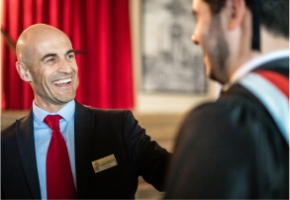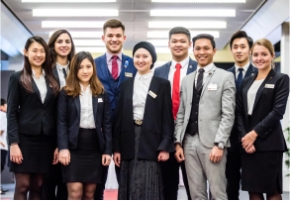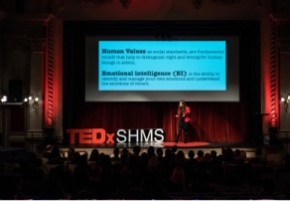- About
- Programs
- Campus life
- Career Services
- Admissions
- News & Events
- Alumni
30 years of innovating: How technology became core to our learning
Find out how Swiss Hotel Management School used technology to enhance the learning experience of all students and why this put our school in such a strong position.
When I joined SHMS in 2004, it was a very traditional school, fixed classes, traditional learning, structured teaching, and formal exams. We taught using whiteboards, each module had its corresponding textbook, and in weeks 9 and 18, all learning stopped for exams.
By 2010, we realized something had to change.
We were simply not preparing our students with the skills for the workplace of the 21st century. It was time to change our approach to teaching, learning, and assessment.
Student-centred learning
We wanted to become more student-centric, we wanted to focus on teaching which encouraged deeper learning. We wanted our students to be active and engaged learners, not passive receivers. We wanted our students to be creative, independent learners, able to innovate and communicate with confidence.
We wanted our students to be active and engaged learners, not passive receivers.
We wanted to instill and develop students’ engagement with the higher levels of learning: analysis, evaluation, and synthesis, as this would secure both academic and career progression.
We rejected the role of teacher as instructor and instead focused on teacher as facilitator. The role of the teacher was now to provide the information and tools for the student to create their own understanding.
We knew how we wanted to teach and to do it successfully we needed new tools. We made the decision to embed technology in every aspect of the student experience.
The journey to a new way of learning
It all sounds quite simple: new pedagogy, new technology. But it didn’t happen overnight, in fact, it was quite a journey.
Pedagogy is the driver; technology is the accelerator. This is important, as without a solid grounding in pedagogy, the technology becomes window dressing, an accessory, and a very expensive accessory. Marketing loves it, but as educators we need it to work for us, we need technology to amplify and accelerate the learning experience of our students.
Pedagogy is the driver; technology is the accelerator.
So, first came the pedagogy, we moved to a student-centric, flipped learning environment, where foundational knowledge is introduced to students before they come to the class. This allows more productive time for applying the knowledge in class, and results in deeper more effective learning.
We knew we wanted to create meaningful and authentic learning experiences for our students. We wanted our students to be autonomous learners, able to identify problems and solve problems, able to set their own goals, and be able to collaborate and communicate effectively to achieve them.
Finding the right tools for the greatest impact
All we needed were the tools to be able to do this with the greatest impact. In 2015, we staged one of the largest deployment of iPads in any school in Switzerland.
Every student received a device preloaded with selected learning apps. The electronic backpack had arrived. We were using iMovies for video submissions and presentations, Pages for reports and collaborative projects, Numbers for creating and sharing spreadsheets, iBooks for interactive learning resources and e-portfolios.
Our students were creating exciting professional standard presentations using Keynote, our teachers were using learning apps for presenting, annotating, setting quizzes, using gamification to award micro-credentials, assessment was transformed, no more time lost for exam week, no more armfuls of paper scripts to carry home.
In 2015, we staged one of the largest deployment of iPads in any school in Switzerland.
Students were everywhere learning, completing activities, discussing projects with research tools at their fingertips, and teachers were going to class with just an iPad tucked under their arm, using their phone to change slides on a keynote presentation, or sending real-time feedback to students using collaborate features.
What could go wrong?
Actually, nothing, it was a huge success. But that did not happen by accident.
A carefully-executed process
We followed a careful process, considered many key factors and sought guidance when necessary.
We started the process by identifying champions to lead the transformation. Those with advanced knowledge and skills were given opportunities and ways to share the enthusiasm across our organization.
We set out goals, stated expectations, discussed what was realistic and achievable. We did research, we shared research, we held meetings. Lots of meetings. We had meetings about meetings.
Training staff
We selected champions who were excited about the change and shared the vision. We knew these would be the drivers and motivators. These champions would overcome the resistance and fear which might have held back others on the team. We sent our champions away to become Apple Distinguished Educators, they came back converts.
We trained up all staff on how to use the iPad, how to use the platforms, how to use the learning apps. We put our staff onto a quest for enlightenment and discovery. The response was hugely positive. Faculty was excited and eager to get their hands on an iPad and start using it. We needed to give our faculty the time and space to play with the technology, but also keep them safe and guided when necessary.
Supporting students
Students were informed in advance that they would be receiving iPads to enhance their learning. On arrival, students were handed an iPad and then immediately given instruction on how to use the device and the apps which had been preloaded. The support was ongoing, we organized informal drop-in sessions for students at time we knew they would be free—lunch to give them the opportunity to ask questions or raise any issues.
Providing support and guidance is key if technology is to be used in a meaningful and inclusive way. Studies show that just handing out devices can increase the performance gap, strong students perform better, while weaker students are further left behind. However, with training the performance gap is reduced and the experience is more inclusive.
Providing support and guidance is key if technology is to be used in a meaningful and inclusive way.
The physical learning environment reflected the needs of the digital campus. Apple TVs were used for presentation of material in class, chairs and tables were reconfigured to facilitate work in small groups, public areas became enabling spaces and learning hubs.
On arrival, students were handed an iPad and then immediately given instruction on how to use the device and the apps which had been preloaded.
Ready to adapt
Because our students were already equipped with the tools and the resources, switching to remote teaching during the pandemic was rapid and less problematic than in other organizations. Our teachers and students had the tools and understood how to use them. Most importantly, the performance and attainment of our students showed no change to previous years, there was very little disruption, exams, assessments could go ahead as normal.
The pandemic did not impact negatively on the learning experience of our students, and this is evidenced not only by their grades, but also by their student satisfaction surveys. The experience of learning during the pandemic showed us how democratic the learning experience can be when all have the equity of digital learning.
In 2004, SHMS was a very good school; today it is internationally recognized as a world-class provider of hospitality education. This is because we understand what we do, how we do it and why we do it.
Pedagogy is the driver, technology the accelerator, we are excited by the future and what comes next, new students, new technology, and new experiences.
This year, Swiss Hotel Management School is celebrating 30 years of hospitality education. As one of the best hospitality schools in the world, we are constantly evolving to stay in tune with the current needs of the hospitality industry. Join us as we celebrate throughout the year and across the globe.
#Academics



















